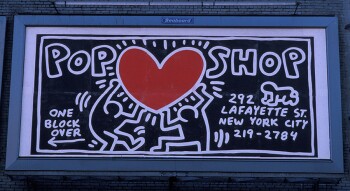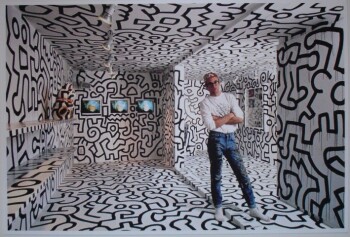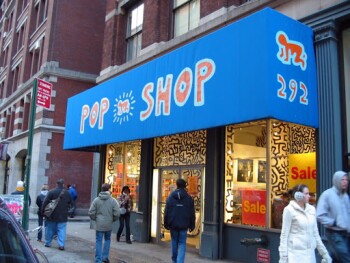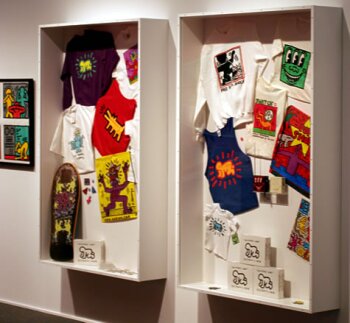S otheby’s is thrilled to present an online sale featuring a rare, unique group of 12 original drawings by Keith Haring. Known as the “Pop Shop Drawings,” these works from 1985 are the iconic images that served as the underlying artwork for Haring’s famous Pop Shop silkscreen prints and other Pop Shop merchandise that transformed his practice into a beloved, global cultural phenomenon.
The 12 drawings to be offered by Sotheby’s present the most significant images from Haring’s visual alphabet: including best buddies, barking dogs, acrobats, and dancers. Each measuring 11 by 14 inches, these equally-sized ink on paper compositions showcase a comprehensive overview of Haring’s characters and motifs that underpin his specific interest in the socio-political themes of his time.
View the Twelve Pop Shop Drawings
“Your line is your personality."
K eith Haring was destined to be an artist. From a young age, Haring grew up learning to draw from his father, and though he was inspired by famous illustrators such as Walt Disney and Dr. Seuss, his father encouraged him to invent his own characters. This impetus to originate his own images rather than to copy or emulate those already existing in the media is what inevitably skyrocketed Haring to fame, gaining first New York City-wide and soon after national and international recognition for his visual lexicon including radiant babies, barking dogs, best buddies, and breakdancers. The present suite of twelve drawings—shown together for the first time since their creation in 1985—encapsulate Haring as a groundbreaking artist of his time, and an artist whose legacy continues to grow and impact the world more than twenty years after his death. Each drawing a career-defining masterpiece, these compositions were integral to Haring’s unconventional yet highly successful Pop Shop which opened in 1986. These drawings mark the inspiration for the set of silkscreen prints bearing the same imagery, and were also the iconic, underlying images which were then realized upon merchandise sold in his store.
Early Years in New York
Haring moved to New York City in 1978 following a short stint at the Ivy School of Professional Art in Pittsburgh—his parents had encouraged him to pursue commercial art, yet he quickly knew that he wanted to pursue a different path. Haring enrolled in the School of Visual Arts and quickly found himself in a thriving community of young artists both at SVA and downtown in the streets, including Kenny Scharf and Jean-Michel Basquiat, who were building their careers outside of the institution of galleries and museums. The young community of artists organized and participated in exhibitions and performances at Club 57, the Mudd Club, and Paradise Garage; through these alternative venues Haring met further arts celebrities of the time such as Andy Warhol, Grace Jones, and Madonna, whom he collaborated with and who supported Haring during his formative years as an artist.

Haring was fascinated by the graffiti he saw around New York City, and he felt an immediate affinity for the work. He saw forms similar to the drawings he was already creating, which boasted strong lines executed without hesitation; Haring never approached a drawing with a premeditated plan. One day on the subway in the early 1980s, Haring noticed a black-papered subway ad and immediately was inspired to draw on the matte paper. He went above ground to purchase a piece of chalk, and after that first drawing, Haring began establishing his vocabulary of images in subway stations all around New York City. Through this act of guerilla art-making, Haring’s images not only became visually recognizable and integrated into the landscape of the city, but the sheer number of drawings allowed Haring to experiment with and ultimately refine his vocabulary of images in his early years as an artist, establishing his alphabet which he would then draw from throughout the span his career.

In June of 1980, Haring participated in The Time Square Show, organized by Collaborative Projects. This landmark exhibition brought together over 100 artists who were primarily street artists working outside of the gallery system; artists such as Kiki Smith, Jenny Holzer, and Basquiat participated and for many of them, it was one of their first shows. Held in an abandoned massage parlor on 41st Street and Seventh Avenue, The Times Square Show provided commentary on democratizing art—this ethos is something that stayed with Haring, who throughout his career felt committed to bridging the gap between the high end art world and street art, endeavoring to make art accessible to everyone.
Haring was working as an assistant for Tony Shafrazi while a student at the School of Visual Arts, yet he never mentioned his own art to the gallerist—he was not interested in gallery representation but instead invested in the burgeoning downtown scene. As his subway drawings and graffiti gained more and more recognition, however, it was gallerists who were interested in him, and once Haring realized he did not have the time to both sell and create work on his own, he joined Tony Shafrazi Gallery and had his first solo show there in 1982—his debut was packed wall-to-wall with Haring’s friends, fans, celebrities, and those already eager to purchase Haring’s work.
Art as a Language
“The drawing itself is a signature.”
Having learned about Semiotics while at SVA, Haring carried forward with him the potential for images to speak as a language. Part of this was recognizing the value of repetition, which Haring employed in his oeuvre starting with his subway drawings; once his visual lexicon was established and recognizable, he continued to repeat the same images using varying mediums throughout his body of work. Haring recognized his ability to craft narratives through the myriad combinations and juxtapositions of his figures, in effect telling a story without words that could be relatable to anyone who came across his work.
While his visual vocabulary builds a narrative, the compositions also embody Haring himself as an artist. The images which became central to his work were also central to his life, and to the broader socio-political issues which he was compelled to address. The radiant baby and barking dog serve as the primal symbols of humanity and life; Haring also addressed central themes such as sexuality, war, friendship, and technology. The present works, which are all equally-sized compositions, incorporate many of his most famous icons, and offer Haring’s unique version of reality told through bold, inky black strokes.
Demonstrated in the twelve drawings are figures such as the tree of life, best buddies, a two-headed barking dog, and breakdancers. These images all recurred throughout Haring’s oeuvre, but in the moment Haring created these drawings, he had already refined his lexicon through drawing in the subway, and was now speaking assuredly using his distinct vocabulary. What is evident in the twelve drawings is Haring’s ability to craft a narrative using his singular visual language: he evokes movement, joy, friendship, and simply the raw, honest energy of being alive. Further affirming their centrality to his body of work, these drawings inspired a series of silkscreen prints bearing the same imagery, and similar iconography was featured in large scale paintings and murals throughout Haring’s accomplished career.
The Pop Shop
“My philosophy was always that art could really communicate to larger numbers of people, instead of the elitist group of people that could afford it and ‘understand it.’”
- 1986
- 1988
- 2005
- 2006
- 2009
-

© Keith Haring Foundation Photo by Tseng Kwong Chi | © Muna Tseng Dance Projects, Inc., New York. 1986The flagship location of the Pop Shop opens on April 19, 1986 in Manhattan's Soho neighborhood, at 292 Lafayette Street. -

Keith Haring in his Tokyo Pop Shop. © Keith Haring Foundation Photo by Tseng Kwong Chi | © Muna Tseng Dance Projects, Inc., New York. 1988A second location of the Pop Shop opens in Tokyo on January 20, 1988. Haring designed merchandise unique to this location, such as fans, kimonos, and rice bowls in addition to his usual bags, buttons, cards, and more. This location of the Pop Shop closed in less than a year, however, due to growing counterfeit production of Haring's merchandise. -
 2005The Soho location of the Pop Shop closes fifteen years after Haring's death. Many mourned the loss of the shop, which served as an embodied memory of the artist.
2005The Soho location of the Pop Shop closes fifteen years after Haring's death. Many mourned the loss of the shop, which served as an embodied memory of the artist. -
 2006An exhibition at the Tampa Museum of Art titled Keith Haring Art & Commerce examined the context and history of the Pop Shop, just one year following the close of the flagship location.
2006An exhibition at the Tampa Museum of Art titled Keith Haring Art & Commerce examined the context and history of the Pop Shop, just one year following the close of the flagship location. -

Photo by Daniel Dame. 2009The Tate Modern reconstructs parts of the Pop Shop as part of the exhibition Pop Life: Art in a Material World, October 2009 - January 2010.
In 1986, Haring opened the flagship location of his Pop Shop in Manhattan’s SoHo neighborhood, with the storefront at 292 Lafayette Street. Taking Warhol’s concept of the factory one step further, Haring saw the Pop Shop as a logical next step from his subway drawings—it was rooted in his desire to make art for a wide range of people, not just collectors and gallery goers. In response to criticism and being called a sell out, Haring explained, “The Pop Shop sort of grew naturally out of what the work was becoming anyway. The images had become part of the world and part of a universal culture. I had to go with that idea and let it happen, let it become part of the culture, let it become part of the mass culture instead of taking it back into the art world and hiding in the art world, which is where I was trying to break out of in the first place.” For Haring, the Pop Shop was itself an art statement, making his work easily accessible to communities throughout New York. It was met with large success, and in 1988 a second location of the Pop Shop opened in Tokyo.

In every way, the Pop Shop was an extension of Haring’s work: he even painted the entire interior of the store with a black and white mural. Through the merchandise sold at his Pop Shop, Haring’s visual vocabulary was even further integrated into the fabric of the city. Posters were sold for a dollar, buttons for 50 cents. Tshirts, sweatshirts, skateboards, and more displaying Haring’s lexicon—images that were essentially established in the twelve drawings comprising the present sale—were available to fans of his work at a low cost, ultimately breaking down the barrier that blocked access to the sphere of an elitist art world. Profits were distributed to children’s charities and educational organizations as well as AIDS research, areas of commitment for Haring that were also incorporated in the mission of the Keith Haring Foundation, established by the artist in1989, one year before his death in 1990 due to AIDS-related complications.
The Pop Shop epitomizes Haring as a revolutionary artist. While he was criticized for “crass commercialism,” at the heart of it, the Pop Shop was not about money (Rolling Stone, Keith Haring: An Intimate Conversation, 1989). It was about accessibility, reaching people, and spreading the creative energy that Haring had. To Haring, art mattered to him when it led to connection, community, awareness, and activism. The twelve drawings included in Keith Haring’s Greatest Hits: The Pop Shop Drawings are the foundation of his mission to spread joy to a wide audience through his art—disseminated on t-shirts and buttons as well as becoming silkscreen prints and large format paintings, these twelve drawings serve as the blueprint for Haring’s oeuvre. With his symbols, Haring had a message and not just that—he opened up a new way of thinking about creation and participation in the world. With their bold line and directness, the Pop Shop drawings express universal concepts that resonate with every viewer on a personal level; they are at the core of what has established Haring as a seminal artist who continues to transcend time.
Large Scale Paintings Referencing Imagery from the Pop Shop Drawings
Visit the Exhibition
Following the guidelines for the Phase Four reopening of Manhattan, we are able to accommodate clients in our building by appointment only. To schedule an appointment to view property from this sale please contact appointmentsNY@sothebys.com or +1 212 606 7171. You can read more about our safety requirements here.










































